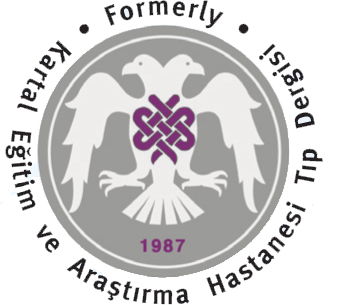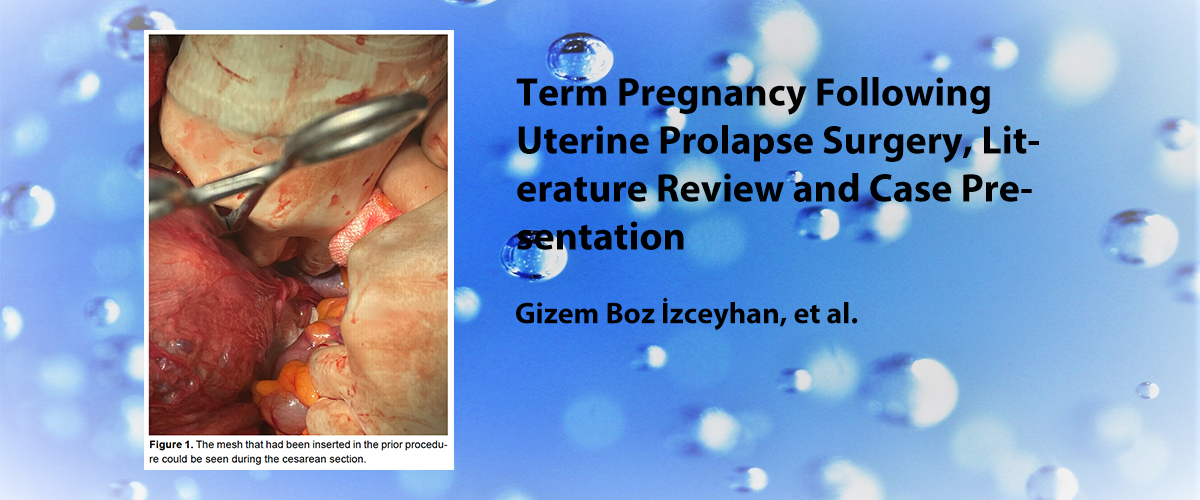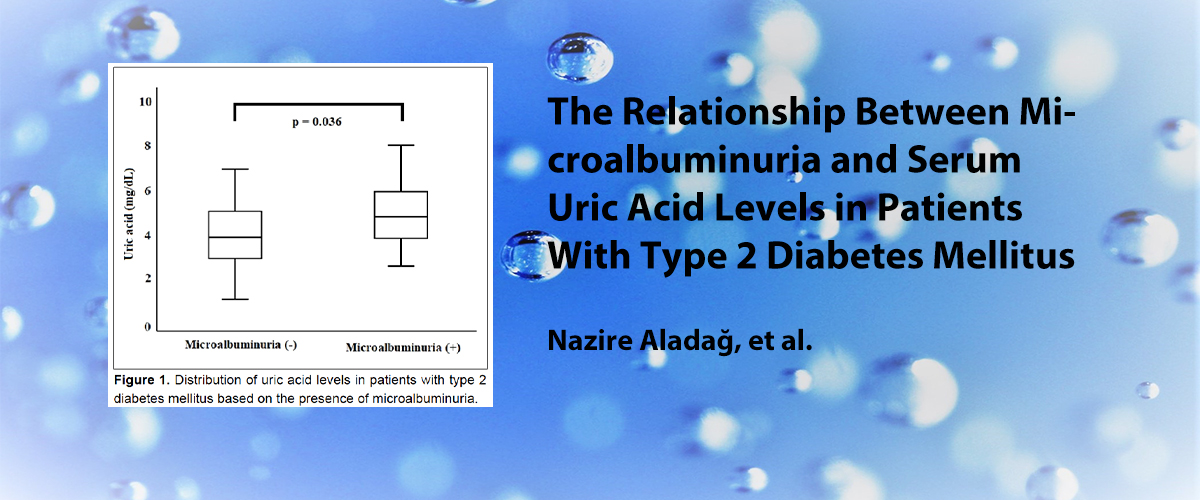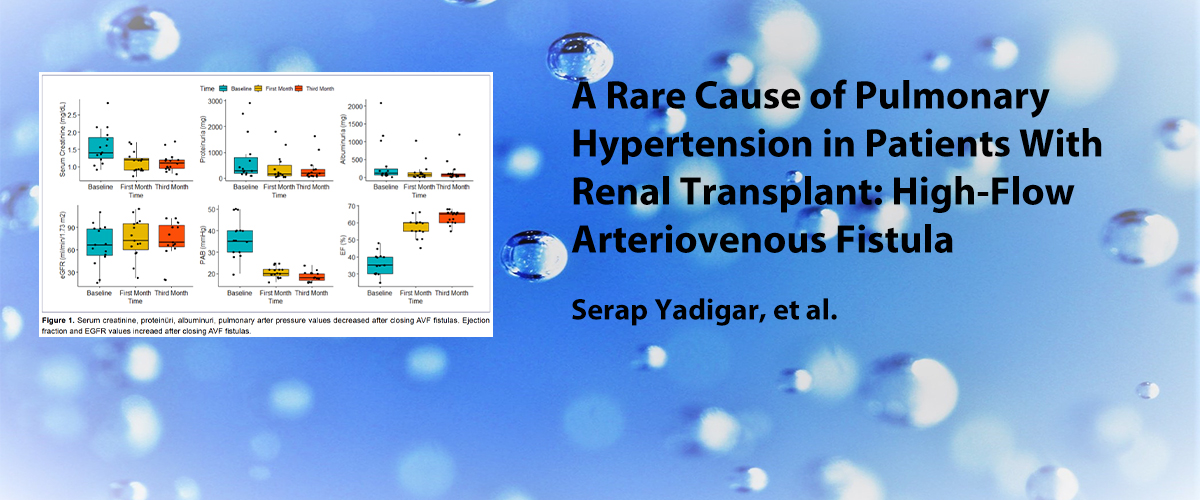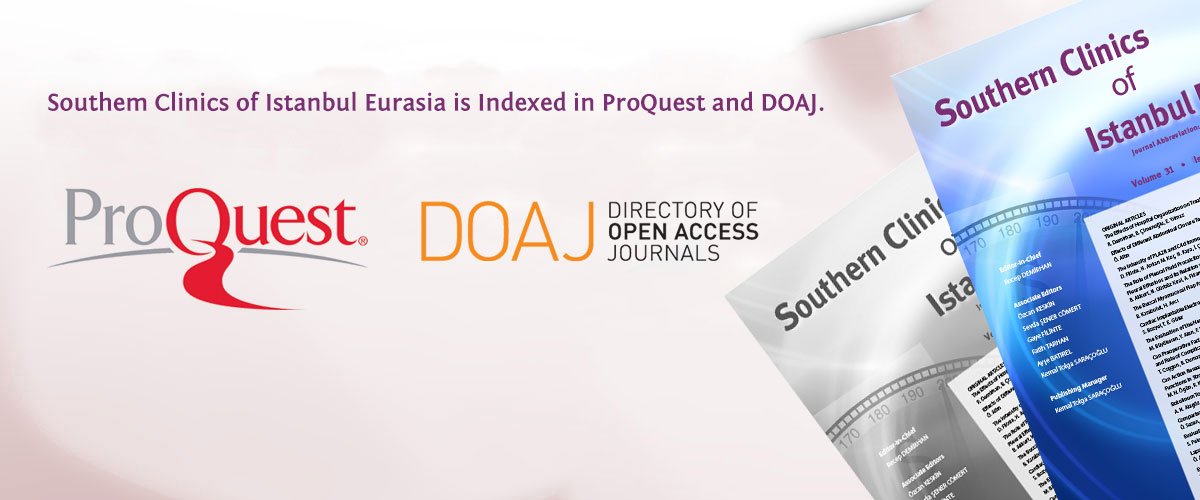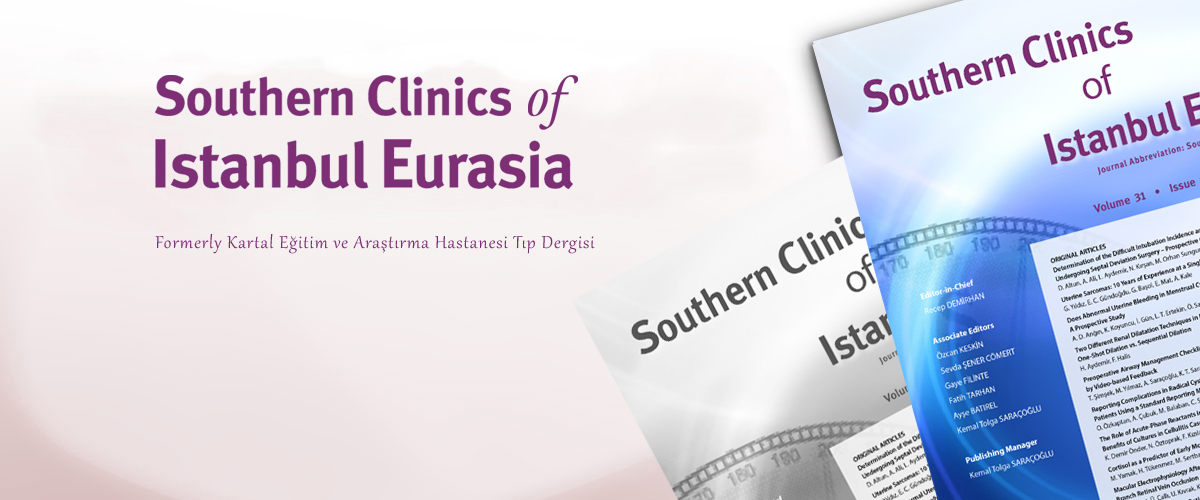E-ISSN : 2587-1404
ISSN : 2587-0998
ISSN : 2587-0998
Cilt: 21 Sayı: 1 - 2010
| ARAŞTIRMA MAKALESI | |
| 1. | Karın ve ekstremite cerrahisi uygulanan olgularda preoperatif pulmoner değerlendirme ile postoperatif pulmoner komplikasyonların ilişkisi Relationship between preoperative evaluation and postoperative pulmonary complications in cases undergoing abdominal and extremity surgery Ali Fidan, Benan Çağlayan, Banu Salepçi, Ülkü Aka Aktürk, Demet Turan, Gülşen Saraç, Nesrin KıralSayfalar 1 - 16 AMAÇ: Bu çalışmada elektif karın ve ekstremite cerrahisi planlanan olgularda preoperatif anamnez, fizik muayene, akciğer grafileri, arter kan gazı (AKG) ve solunum fonksiyon testlerinin (SFT) postoperatif pulmoner komplikasyon (PPK) riskini belirlemedeki etkinliği, postoperatif dönemde SFT ve AKG değişimleri, anestezi tipi ve ameliyat yerinin PPK gelişimindeki etkisi değerlendirildi. YÖNTEMLER: Hastanemizde 30una karın, 30una ekstremite ameliyatı planlanan toplam 60 olgu prospektif olarak incelendi. Her iki grubun preoperatif ve postopreatif klinik, radyolojik ve laboratuvar bulguları PPK açısından değerlendirildi. İstatistiksel analizlerde ki-kare, Mann-Whitney U ve Wilcoxon testleri kullanıldı. BULGULAR: Olguların 36sı (%60) erkek, 24ü (%40) kadın, yaş ortalaması 42,62±16,61 idi. Karın ameliyatı, vücut kitle indeksi (VKİ) >27, sigara >20 paket-yılı, ek hastalık, solunumsal semptom varlığı, anormal akciğer grafi bulguları, ASA sınıfı >I, ileri yaş, maksimal istemli ventilasyon (MVV) düşüklüğü ve rezidüel volüm/total akciğer kapasitesi (RV/TLC) yüksekliği PPK gelişimi üzerinde etkili olarak bulundu. Karın grubunda 8 (%26,7) olguda, ekstremite grubunda ise sadece 1 (%3,3) olguda PPK izlendi (p<0,05 OR=10,54 %95 GA: 1,22-90,66). Karın ameliyatı sonrasında FVC, FEV1, FEF25-75, PEF, RV, karbon monoksit difüzyon kapasitesi (DLCO) ve PEmaxta, PaO2 ve SaO2de anlamlı azalma olurken; ekstremite ameliyatı sonrasında sadece DLCOdaki azalma anlamlıydı. SONUÇ: Sonuç olarak, karın ameliyatında PPK riski anlamlı derecede yüksektir. PPK riskini belirlemede SFT ve AKG gibi ileri teknik donanım gerektiren yöntemler olmaksızın ASA sınıflaması, VKİ, respiratuvar semptom ve sigara öyküsü ile akciğer grafisi kullanılarak yeterli önfikir edinilebilir. Gerek duyulduğunda MVV ve RV/TLC risk açısından uyarıcı olabilir. OBJECTIVE: The effects of preoperative history, physical examination, chest X-ray, arterial blood gas (ABG) analysis, and pulmonary function test (PFT) in determining the risk of postoperative pulmonary complications (PPC) of elective abdominal and extremity surgery were investigated. PFT and ABG changes in the postoperative period, effect of anesthesia type and operation site with respect to PPC were also evaluated. METHODS: Sixty (30 abdominal, 30 extremity) cases were prospectively analyzed. Preoperative and postoperative clinical, radiological and laboratory data in both groups were analyzed regarding PPC. Chi-square, Mann-Whitney U and Wilcoxon tests were used in the statistical analysis. RESULTS: The mean age of 36 (60%) male and 24 (40%) female patients was 42.62±16.61. Abdominal surgery, body mass index (BMI) >27, smoking >20 pack-years, comorbidity, respiratory symptoms, chest X-ray abnormalities, ASA>1, advanced age, decreased maximal voluntary ventilation (MVV), and increased residual volume/total lung capacity (RV/TLC) were associated with increased PPC risk. Eight (26.7%) patients in the abdominal group had PPC compared to only 1 (3.3%) patient in the extremity group. After abdominal surgery, FVC, FEV1, FEF25-75, PEF, RV, diffusion lung capacity for carbon monoxide (DLCO), and PEmax, PaO2, SaO2 showed significant postoperative decrease, whereas only DLCO decreased following extremity surgery. CONCLUSION: Following abdominal surgery, PPC risk is significantly increased. In order to determine PPC risk, ASA classification, BMI, respiratory symptoms, smoking habit, and chest X-ray are sufficient, and there is no need for more sophisticated tests such as PFT and ABG. Whenever needed, MVV and RV/TLC values may help in the risk determination. |
| 2. | Açık cerrahi girişimlerde dorsal lumbotomi ve flank insizyonu Comparison of dorsal lumbotomy and flank incision in open surgery procedures Abdulmuttalip Şimşek, Levent Özcan, Ömer Kurt, Osman Köse, Yusuf İlbey, Emin Özbek, Yavuz ÖnolSayfalar 17 - 21 AMAÇ: Dorsal lumbotomi insizyonunu ameliyat süresi, postoperatif ağrı, analjezik gereksinimi ve yara komplikasyonları yönünden flank insizyonu ile karşılaştırmayı amaçladık. YÖNTEMLER: Kliniğimizde 2005-2008 yılları arasında değişik endikasyonlarla dorsal lumbotomi insizyonu kullanılarak ameliyat edilen 22 hastanın kayıtları geriye dönük olarak tarandı. Hastaların ameliyat endikasyonları, ameliyat süreleri, postoperatif ilk 24 saatte kullanılan analjezik miktarı, hastanede kalış süreleri incelendi. Aynı dönemde flank insizyonla ameliyat edilen 50 hastanın kayıtları da dorsal lumbotomi ile kıyaslamak için aynı ölçütler dikkate alınarak geriye dönük olarak tarandı. BULGULAR: Yirmi iki hastaya lumbotomi insizyonu uygulandı. Hastaların ortalama yaşı 34 (dağılım, 3-70) idi. Hastaların 13ü erkek, 9u kadındı. Dorsal lumbotomi endikasyonları 8 hastada üreteropelvik bileşke darlığı (UPJ darlığı), 11 hastada pelvis taşı, 2 hastada alt pol taşı, 1 hastada da proksimal üreter taşından oluşuyordu. Flank insizyonla operasyon endikasyonları basit nefrektomi, UPJ darlığı ve proksimal üreter taşından oluşuyordu. Ameliyat süreleri değerlendirildiğinde dorsal lumbotomi insizyonu ile ameliyat süresi üst üreter taşları için 30 dakika, piyeloplasti ameliyatı için 25 dakika daha kısa bulundu. İlk 24 saatte analjezik gereksinimi lumbodorsal insizyon ile yapılan ameliyatlarda belirgin olarak azdı. Hiçbir hastada cerrahi yara komplikasyonu gözlenmedi. SONUÇ: Günümüzde üst üriner sistem cerrahisinde minimal invaziv işlemler (PCNL, ESWL, URS) tedavi alternatifleri arasında ön planda olmasına rağmen, açık cerrahi gerektiği zaman dorsal lumbotomi insizyonunun ilk tercih olabileceğini düşünmekteyiz. OBJECTIVE: We aimed to investigate dorsal lumbotomy incision with respect to the duration of the operation, postoperative pain, analgesic requirement, and wound complications, and results were compared with respect to flank incision. METHODS: Dorsal lumbotomy incision was performed in 22 patients who underwent operation with different indications between 2005 and 2008, and patient files were scanned retrospectively. Operation indication, operation duration, the postoperative first 24-hour analgesic medication requirement, and hospitalization time were examined. Fifty patients who underwent flank incision in the same period taking into account the same criteria were retrospectively reviewed and compared with the dorsal lumbotomy patient group. RESULTS: Lumbotomy incision was applied in 22 patients (13 male, 9 female). The mean age of patients was 34 years (range: 3-70 years). Indications for dorsal lumbotomy were ureteropelvic junction obstruction in 8 patients; renal pelvis calculi in 11 patients, lower pole renal calculi in 2 patients, and proximal ureteral calculi in 1 patient. Indications for flank incision were simple nephrectomy, ureteropelvic junction obstruction, and proximal ureteralcalculi. When operation times were evaluated, operation time with dorsal lumbotomy incision was 30 minutes shorter for proximal ureteral calculi and 25 minutes shorter for pyeloplasty operations. The postoperative first 24-hour analgesic medication need of patients operated via dorsal lumbotomy incision was distinctly less. No surgical lesion complication was observed in any of the patients. CONCLUSION: Although minimally invasive approaches (PCNL, ESWL, URS) are performed today in upper urinary tract surgeries when open surgery is needed, we think dorsal lumbotomy incision will be the first choice. |
| 3. | Çocuk tonsillektomilerinde bipolar koter diseksiyon ve klasik diseksiyon tekniklerinin karşılaştırılması Comparison between bipolar cautery dissection and classic dissection techniques in pediatric tonsillectomy Mahmut ÖzkırışSayfalar 22 - 27 AMAÇ: Çocuk hastalarda klasik diseksiyon ve bipolar koter diseksiyon tonsillektomi sonuçları karşılaştırıldı. YÖNTEMLER: Tonsillektomi planlanan 185 çocuk hasta rastgele iki gruba ayrıldı. Doksan beş hastaya (52 erkek, 43 kız; ort. yaş 8±4) bipolar koter tonsillektomisi yapılırken, 90 hastaya (47 erkek, 43 kız; ort. yaş 8±4) klasik diseksiyon tonsillektomi uygulandı. İki grupta tonsillektomi sırasında kanama miktarı, ameliyat süresi, primer ve sekonder kanama, ameliyat sonrası 2. saat ve 10. gündeki ağrı şiddetleri karşılaştırıldı. BULGULAR: Bipolar koter tonsillektomi grubunda ortalama ameliyat süresi, ameliyat sırasındaki kanama miktarı ve ameliyat sonrası 2. saatte ölçülen ağrı skoru anlamlı derecede düşük bulundu (p<0,001). Ancak, bipolar koter tonsillektomi grubunda 10. günde ortalama ağrı skoru anlamlı derecede yüksekti (p<0,001); bu durum ilk katı gıda alımını da anlamlı derecede geciktirdi (p<0.001). İki grupta da üçer hastada ameliyat sonrası geç kanama nedeniyle genel anestezi altında kanama kontrolü yapıldı. SONUÇ: Bipolar koter tonsillektomi güvenli bir tekniktir. Hem operasyon süresini kısaltmakta hem de operasyon süresince daha az kanama olmaktadır. Tonsillektomi yapılacak çocuklarda her iki yöntemin avantaj ve dezavantajlarının hasta seçiminde göz önüne alınması gerekmektedir. OBJECTIVE: We compared the results of tonsillectomy performed by classical dissection and bipolar cautery dissection in pediatric patients. METHODS: A total of 185 pediatric patients were randomly assigned to two tonsillectomy groups. Ninety-five patients (52 boys, 43 girls; mean age 8±4 years) underwent bipolar cautery tonsillectomy, and 90 patients (47 boys, 43 girls; mean age 8±4 years) underwent classical dissection tonsillectomy. Patients were compared with respect to bleeding during tonsillectomy, operation time, primary and secondary bleeding, and severity of pain at the second hour and on the tenth day. RESULTS: With bipolar cautery tonsillectomy, the mean operation time, amount of perioperative bleeding and pain score at the second hour were significantly lower (p<0.001). However, the mean pain score on the tenth day was significantly higher with cautery tonsillectomy, which significantly prolonged initiation of solid food intake (p<0.001). In the late postoperative period, three patients in each group required intervention under general anesthesia to control bleeding. CONCLUSION: Bipolar dissection tonsillectomy is a safe technique. It significantly reduces the operative time and intraoperative blood loss. Merits and demerits of both techniques should be taken into consideration for appropriate patient selection for the two tonsillectomy methods. |
| 4. | Tıp fakültesi çocuk acil ünitesine gönderilen cerrahi olmayan hastaların nakil şartlarının değerlendirilmesi Evaluation of transport conditions of non-surgical patients referred to the pediatric emergency unit of a medical faculty Murat Tutanç, Vefik Arıca, Fatmagül Başarslan, Seçil Günher Arıca, Ali Karakuş, İbrahim Şilfeler, Mehmet Tayip Arslan, Servet Yel, Halil Kocamaz, Kenan Haspolat, Mehmet BoşnakSayfalar 28 - 32 AMAÇ: Bu çalışmada, çocuk acil ünitesine (ÇAÜ) getirilen cerrahi olmayan çocuk hastaların taşınma şartları değerlendirildi. YÖNTEMLER: Eylül 2004 ile Kasım 2004 ayları arasında değişik hastanelerden sevk edilen 166 çocuk hasta çalışmaya dahil edildi. Çocuk acile uğramadan erişkin acile giden travmatik hastalar ve farklı nakil şartları gerektiren yeni doğanlar çalışmaya dahil edilmedi. BULGULAR: Nakil edilen hastaların 76sı kız (%45,7), 90ı erkek (%54,3) idi. Yirmi altı hastanın (%15,6) sağlık güvencesi yoktu. Nakil kararının 141ini (%84,9) uzman doktor verirken, 6 (%5) hastada sevk eden belirlenemedi. Yüz otuz hastada (%59) nakil öncesi hastaya ait bilgi yetersizdi. Nakillerin 72si (%43) ambulansla yapılırken bu ambulansların 10u (%6) tam teşekküllü idi. Eşlik eden personelin 5i (%3) doktor, 14ü (%8,4) hemşire idi. Diğerleri tecrübesiz veya eğitimsizdi. Hastaların 152sinin (%91,5) yatırılarak tedavisine başlandı. Hastaların 29u (%17) ÇAÜye vardığında agonizan haldeydi. SONUÇ: Hastaların hastaneler arası nakli sırasındaki uygulamaların eksik ve yetersiz olduğu ve bu konuda düzenlemelere gerek duyulduğu kanısına varıldı. OBJECTIVE: The aim of this study was to evaluate the transport condition of pediatric patients who were admitted to the pediatric emergency unit of a medical faculty hospital. METHODS: The present study included 166 children (76 [45.7%] female, 90 [54.3%] male) who were referred to the pediatric emergency unit of a medical faculty hospital from different state hospitals between September 2004 and November 2004. The exclusion criteria were traumatic patients and newborns. Twenty-six patients (15.6%) had no medical insurance. RESULTS: One hundred forty-one (84.9%) of 166 patients were transported to our emergency unit based on the decision of specialists. It could not be determined who gave the transport decision in six (3.6%) patients. Referral information about 130 (59%) patients was inadequate for transportation. Seventy-two (43%) patients were transported by ambulance; of these, only 10 (6%) ambulances were fully equipped. Accompanying persons during transportation included 5 (3%) doctors and 14 (8.4%) nurses. The others persons were inexperienced or uneducated. One hundred fifty-two (91.5%) of the patients were treated by hospitalization. Twenty-nine (17%) patients were in severe distress when they were admitted to the emergency department. CONCLUSION: It was concluded that current patient transportation procedures are unorganized and insufficient, and detailed arrangements should be carried out during this period. |
| OLGU SUNUMU | |
| 5. | Glukoz-6-fosfat dehidrogenaz eksikliği: Olgu sunumu Glucose-6-phosphate dehydrogenase deficiency: Case report Hakan Erkal, Elif Atar Gaygusuz, Yaman Özyurt, Feriha TemizelSayfalar 33 - 36 Glukoz-6-fosfat dehidrogenaz (G6PD) enzim eksikliği en sık görülen enzim yetersizliğidir ve yenidoğan hiperbilüribimemisi, akut veya kronik hemoliz gibi bir dizi bozukluklara neden olur. Eritrositlerde oksidan hasara karşı savunma, asıl olarak G6PD aktivitesine bağlıdır. G6PD enzimi pentoz fosfat yolunda ilk adım olan yolu katalizleyerek hücreleri oksidatif hasardan koruyan antioksidanların oluşumuna neden olur. G6PD yetmezliği olan hasta bazı ilaçlar, bazı metabolik durumlar ve enfeksiyonlar sonucu kırmızı kan hücrelerinde oksidatif stres gelişen durumlarda hücreleri koruyamaz. Bu yazıda, G6PD enzim eksikliği olan bir hastadaki genel anestezi uygulaması sunuldu. On aylık erkek hastaya beyin cerrahisi ameliyatı için genel anestezi uygulandı. Ameliyat ve ameliyat sonrası dönem sorunsuz seyretti. Hemolitik sorunlar, malign hipertermi veya methemoglobinemi görülmedi. G6PD olan olgularda, özel dikkat ile genel anestezinin güvenle uygulanabileceğini düşünmekteyiz. Glucose-6-phosphate dehydrogenase (G6PD) deficiency, the most common enzyme deficiency, causes a spectrum of disease including neonatal hyperbilirubinemia, acute hemolysis or chronic hemolysis. In red cells, defense against oxidative damage is essentially dependent on G6PD enzyme activity. This enzyme catalyzes the first step in the pentose phosphate pathway, leading to antioxidants that protect cells against oxidative damage. A G6PD-deficient patient, therefore, lacks the ability to protect red blood cells against oxidative stresses from certain drugs, metabolic conditions and infections. This report presents a case of general anesthesia management in a patient with G6PD deficiency. A 10-month-old male with G6PD deficiency was scheduled for neurosurgical operation under general anesthesia. The intraoperative and postoperative course was uneventful with respect to hemolytic problems, malignant hyperthermia or methemoglobinemia. We think that general anesthesia can be performed successfully with special attention in patients with G6PD deficiency. |
| 6. | Üveitle birlikte tekrarlayan spontan hifema: Olgu sunumu Recurrent spontaneous hyphema with uveitis: Case report Mehmet Orçun Akdemir, Ümit Aykan, Baran KandemirSayfalar 37 - 40 Yetmiş altı yaşında erkek hasta kliniğimize sağ gözünde 2 gün önce başlayan görme azalması nedeniyle başvurdu. Sağ gözde total hifema mevcuttu ve hifema nedeniyle ön kamara yapıları seçilemiyordu. Hastanın kliniğimizde yatışı sırasında hematoloji ve dahiliye konsültasyonları detaylı incelemelerle beraber gerçekleştirildi. Hastanın hematolojik ve romatolojik incelemesinde anormallik saptanmadı. Hastaya ön segment anjiyografisi, fundus floresein anjiyografisi ve ön segment ulrason biyomikroskopisi yapıldı, patoloji saptanmadı. Olguda yüksek doz steroid ile baskıladığımız üveit mevcuttu. Üveit spontan hifemalı olgularda akılda bulundurulması gereken bir oküler hastalıktır. A 76-year-old male patient with decreased vision starting two days before in the right eye was referred to our clinic. He had total hyphema in the right eye and the anterior chamber could not be seen clearly. Hematology and internal medicine consultations with detailed examinations were performed. Hematological and rheumatological examinations revealed no pathology. We examined the patient with anterior chamber angiography, fundus fluorescein angiography and anterior chamber ultrasonographic biomicroscopy, and again no pathology was evident. The patient had uveitis, which was treated with high-dose topical steroid. Uveitis is an ocular pathology that must be kept in mind as the cause of spontaneous hyphema. |
| 7. | Tüp torakostomi sonrası gelişen reekspansiyonel akciğer ödemi: Olgu sunumu Reexpansion pulmonary edema developed after application of tube thoracostomy: Case report Tamer Kuzucuoğlu, Elif Atar, İzzet Alatlı, Emel Maylı DalSayfalar 41 - 44 Reekspansiyonel pulmoner ödem (RPÖ), akciğerin ekspansiyonu sonrası gelişen nadir bir komplikasyondur. RPÖ hemopnomotoraks, geniş plevral efüzyon, pnömotoraks, lobektomi sonrası ve tek akciğer ventilasyonu sırasında oluşabilmektedir. Otuz yaşında erkek hasta, sağ yan ağrısı ve dispne şikayeti ile geldi. Çekilen akciğer grafisinde sağ total spontan pnömotoraks saptandı. Sağ tüp torakostomi takıldı. Tüp torakostomi takıldıktan 2 saat sonra RPÖ gelişmesi ve klinik durumun bozulması üzerine takip ve tedavi amacıyla yoğun bakıma alındı. Yoğun bakım takip sürecinde sıvı kısıtlaması, diüretik ve oksijen desteği uygulandı. Sürekli pozitif havayolu basıncı (CPAP) uygulaması yapılarak oksijenizasyon düzeltildi. Bu yazıda, olgunun yoğun bakım tedavi basamakları ve klinik sürecinin sunulması amaçlandı. Reexpansion pulmonary edema (RPE) is a rarely seen clinical complication and seems due to expansion of the lung. This condition develops due to hemopneumothorax, wide pleural effusion pneumothorax, after lobectomy, and during one-lung ventilation. Our case was a 30-year-old man who presented with chest pain on the right side and dyspnea. Chest roentgenogram revealed a right-sided spontaneous pneumothorax. Tube thoracostomy was performed. A right-sided RPE was seen on the roentgenogram after tube thoracostomy. After two hours, tube thoracostomy RPE developed, and he was then transferred to intensive care. During this period fluid restriction, diuretic and oxygen support therapy were applied. His clinical condition improved with continuous positive airway pressure (CPAP) therapy. With this case, we aimed to present the treatment steps and clinical progress of a patient with RPE. |
| 8. | Atipik prezentasyonlu brusellozis olgusu: Akut hepatit Unusual presentation of brucella case: Acute hepatitis Vefik Arıca, Seçil Günher Arıca, İbrahim Şilfeler, Hatice Onur, Mehmet TanırSayfalar 45 - 48 Bruselloz gelişmekte olan ülkelerde halen sık rastlanan bir hastalıktır. Brusella enfeksiyonu Türkiyenin Doğu ve Güneydoğu bölgelerinde endemik olarak görülmektedir. Ülkemizde yılda yaklaşık 18.000 yeni olgu tespit edilmektedir. Bruselloz yaygın tutulumu olan bir hastalıktır. Birçok organ veya sistem tutulabilir. Gastrointestinal sistemde nadiren hepatit enfeksiyonlarına neden olabilir. Biz de bu yazıda çocuk kliniğimizde takip ettiğimiz brusellaya bağlı bir akut hepatit olgusunu sunuyoruz. On dört yaşında erkek hasta yaygın kas ağrıları, halsizlik, kilo kaybı, yüksek ateş ve kusma nedeniyle yatırıldı. Yapılan fizik muayenede cilt, skleralar ve mukozalar ikterik, karaciğer 4-5 cm palpabl idi. Laboratuvar incelemede, AST: 1310 U/L, ALT: 682 U/L, GGT: 744 U/L, ALP: 402 U/L, total bilirubin: 4,2 mg/dL, direkt bilirubin: 1,9 mg/dL idi. Viral markerler negatif idi. Brusella tüp aglütinasyon testi pozitif (1/320) olan ve kan kültüründe Brucella spp. üreyen hastaya streptomisin ve doksisiklin ile tedaviye başlandı. Tedavinin 3. gününden itibaren klinik cevap alınmaya başlandı. Tedavisinin 21. gününde AST, ALT ve bilirubin değerleri normal olan hasta taburcu edilerek tedavisi 8 haftaya tamamlandı. Olgu sunumunun amacı ülkemiz gibi brusella enfeksiyonun endemik olduğu bölgelerde akut hepatit ayırıcı tanısında brusellozun önemini vurgulamaktır. Brucellosis is a still frequently encountered disease in developing countries. Brucella infection is seen endemically in East and Southeast Turkey. Each year approximately 18.000 new cases are reported in our country. Brucellosis infects multiple systems within the body. Many organs and systems may be involved in brucella infection. Gastrointestinal involvement in brucellosis may rarely result in hepatitis. We present herein an acute hepatitis case due to brucella. A 14-year-old male patient presented with diffuse myalgia, weight loss, fever, vomiting, and fatigue. Physical examination revealed that skin, sclera and mucosal surfaces were all icteric, and the liver was palpable 4-5 cm below the costal margin. Laboratory investigations revealed aspartate aminotransferase (AST) 1310 U/L, alanine aminotransferase (ALT) 682 U/L, gamma glutamyl transpeptidase (GGT) 744 U/L, alkaline phosphatase (ALP) 402 U/L, total bilirubin 4.2 mg/dl, and conjugated bilirubin 1.9 mg/dl. Viral markers for hepatitis A, B and C were all negative. Brucella tube agglutination test was positive (1/320) and hemoculture revealed Brucella spp. Streptomycin and doxycycline treatment was initiated. Clinical response was noted within the 3rd day of treatment, and ALT, AST and total bilirubin levels returned to their normal levels on the 21st day of the treatment. Treatment lasted for 8 weeks. We present this case to underline that brucellosis should be kept in mind in the differential diagnosis of acute hepatitis, especially in regions where brucellosis is endemic. |
| DERLEME | |
| 9. | Probiyotikler Probiotics Yavuz Yeşilova, Bilal Sula, Engin Yavuz, Derya UçmakSayfalar 49 - 56 Makale Özeti | |

